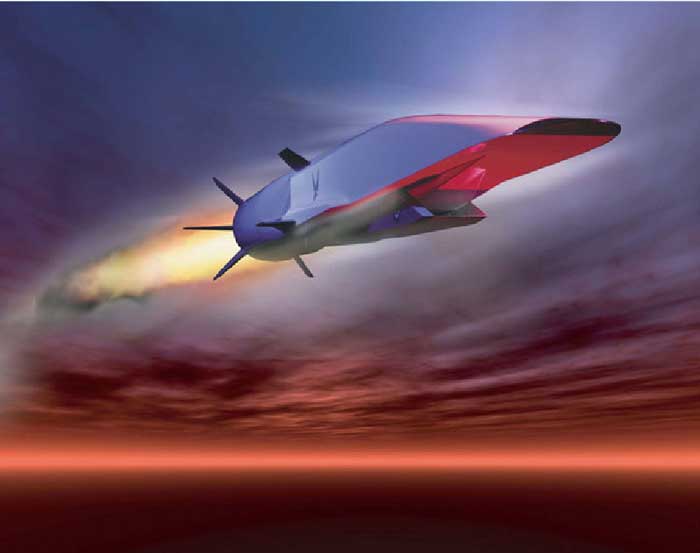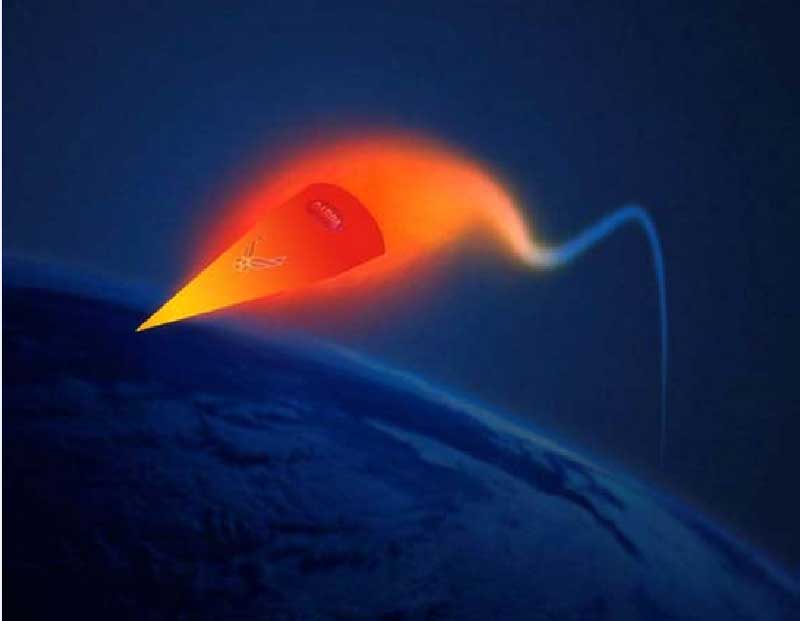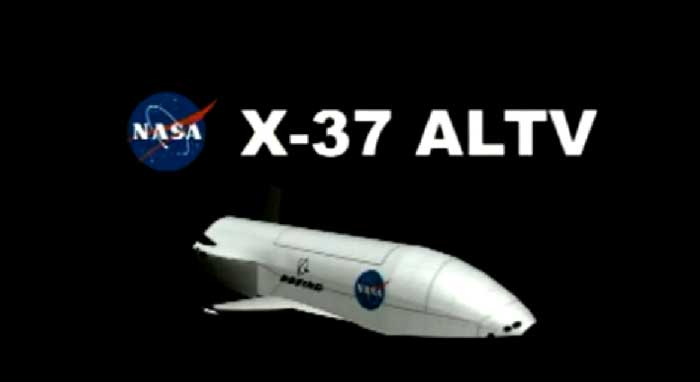An Interview With Professor Lewis
03/22/2011 – In January 2011, Second Line of Defense sat down with Professor Lewis to discuss the current status and dynamics of hypersonics [1]. Mark J. Lewis is chairman of Clark School’s Department of Aerospace Engineering at the University of Maryland, College Park, and President of the American Institute of Aeronautics and Astronautics. He was the chief scientist of the U.S. Air Force from 2004 to 2008.
 This Air Force illustration depicts the X-51A Waverider scramjet vehicle during hypersonic flight during its May 26, 2010 test. Powered by a Pratt & Whitney Rocketdyne SJY61 scramjet engine, it is designed to ride on its own shockwave and accelerate to about Mach 6. (Credit: www.space.com)
This Air Force illustration depicts the X-51A Waverider scramjet vehicle during hypersonic flight during its May 26, 2010 test. Powered by a Pratt & Whitney Rocketdyne SJY61 scramjet engine, it is designed to ride on its own shockwave and accelerate to about Mach 6. (Credit: www.space.com)
SLD: You have provided a very helpful background on hypersonics. Now let us return to the question of the progress last year.
Lewis: There were three flights: X-37, HTV-2 and X-51. Now let me explain their significance in that order.
The flight of X-37 was exciting because in many ways it was a return to the future we were supposed to have. X-37 was a relatively traditional hypersonic vehicle in the sense that it had blunt leading edges, built very much along the same lines as the Space Shuttle orbiters. In other words, X-37 wasn’t a sharp leading edge accelerating vehicle. It was a spacecraft, but it captured an idea from the 1960s, which I think has tremendous merit, and that is the idea of the small winged orbital vehicle. Having wings gives you operational flexibility. It lets the vehicle land on a conventional runway, taxi, and be refurbished to fly again. X-37 is thus similar to the space shuttle, except the space shuttle is much larger. Also, X-37 was unmanned.
The Space Shuttle has a huge cargo bay, which is good for some things, but not for all payloads. Flying the Space Shuttle every time you want to launch a payload into space is like flying a C-5 every time you want to deliver a package, no matter how small that package might be. The X-37 points the way to much smaller spacecraft that can do much more flexible missions into space at lower cost. But really, from a technology standpoint, it didn’t quite push the envelope, except perhaps for its autonomous control.
The next flight, HTV-2 was a DARPA-led effort. HTV-2 was a very slender, sharp-leading-edged, maneuvering re-entry vehicle. Though a research craft, it points the way towards global long-range strike systems. HTV-2 was launched on a conventional rocket. If made operational, it could boost and glide to almost anywhere on the globe—very effective as a conventional strike system.
HTV-2 was not powered, so it didn’t really push the state of the art in propulsion. It did push the frontiers of aerodynamics and material. To be honest, the first HTV-2 flight also was really a failure: it was lost half way through its fight. That is in part because DARPA initially didn’t make enough of an investment in understanding the aerodynamics
So from the standpoint of its being a flight experiment, HTV-2 was a failure, but as a teaching moment, it was also a success, because it reminded us the things that we don’t know about flying at high speed. And to DARPA’s great credit, as soon as that flight occurred and the vehicle was lost, they began a significant investment in wind tunnel tests and computational studies to try to understand what went wrong.

The third vehicle, and frankly the one that I’m most excited about, is the X-51. I am also especially proud of X-51 because it came right out of the Air Force Research Laboratory. X-51 was a flight test vehicle dropped off the wing of a B-52, designed to represent a vehicle such as a hypersonic cruise missile, with a corresponding mission of flying several hundreds of nautical miles in under a few minutes.
But the most important thing about X-51 is that it was a flight test bed for propulsion technology, propulsion that could power a vehicle operating in the atmosphere at hypersonic speeds. The type of engine that powered X-51 is something called a supersonic combustion ramjet or scramjet.
Let me explain what a scramjet is – in some ways it is the simplest engine you could imagine operating the atmosphere. It’s got a hole in the front; air comes in, fuel squirts in, mixes, burns, and the hot gases accelerate out the back. However, building a scramjet that can operate at hypersonic speeds is a considerable challenge. At those speeds, there is very little time for the fuel to mix and burn- on the order of thousandths of a second. And temperatures are so hot that they push material limits.
The X-51 vehicle included tremendous developments in the technology associated with scramjet engines. Although its first flight in May was not 100% successful, it did teach us the things we needed to learn about flying at those speeds.
SLD: You were talking about ubiquitous presence, speed of light, and again we want to go as quickly as you can, different kinds of approaches to how you use the assets.
I think one of the most important things that gets lost when you’re talking about a new technology, like potentially hypersonics can deliver, is when we describe it as game changing, which it certainly is, but it means also that it’s a tool that you’re adding to the toolbox which is iterative. It interacts with all the other things in your toolbox to make them more effective.
And our expectation is for rapid success or if we don’t get rapid success, we think we have failed. What I’ve been concerned about is our tolerance for testing’s low. Our budgeting for testing’s low. Our willingness to allow new systems to have their place to get inserted, whether they be CH-53Ks or Ospreys or whatever. So that’s one problem.
The second problem that I see is that if we make this transition in air power towards distributed ops, as you add long-range strike capabilities, it really allows you to use that grid very, very differently because now if I’m laying the grid on a region because I need to be there, then I can direct a hypersonic strike, or I can lead with a hypersonic strike because I think at the heart of the problem that I see is that it’s not a 1991 scenario.
We know that a lot of what we want to affect is mobile, fleeting, and a hard to find and kill, so just so if I can get there with quick speed to affect something that’s fleeting or moved with strike, I would have failed.
But the issue is because I’m addressing through stealth my ability to manage areas where there’s going to be fleeting targets, if I now have stealth plus speed I have a very flexible set of assets to manage threat environments.
Lewis: Absolutely. I could not agree more. If I can, let me pick up on your first point. I could not agree more about your comments about testing. We’re unwilling to make the proper investment in testing. We’re unwilling to accept risks in testing. And we are shortsighted in funding our valuable testing infrastructure, such as wind tunnels and test cells.
I mentioned the X-15 program earlier. They took risks. Remember, they did 199 flights with three vehicles, and even towards the end of the program, when they tragically lost an X-15 and a pilot was killed, it didn’t end the program.
Today, when we have a small failure on even an unmanned flight test, we spend sometimes years studying our navel to figure out what could possibly have gone wrong before we’ve got enough the nerve to fly again.
 X-37, Video from NASA (Credit: www.youtube.com)
X-37, Video from NASA (Credit: www.youtube.com)
When I was Chief Scientist we started an Air Force program called HiFire. It was also under Mike Wynne’s watch. HiFire is a joint effort between the United States Air Force and the Australian Defence Science and Technology Organization, with additional support from NASA and industry. The program is doing a series of hypersonic flight tests in the Australian Outback. That’s using relatively small rockets flying modest experiments, but the going-in mantra was “we’re willing to fail” – if the rocket blows up and we deliver the payload to the sands of the outback, then we’re going to fly again, and we’re not going to spend two years trying to figure out what went wrong. So you’re absolutely right.
I see across the board an unwillingness to make the investment in testing infrastructure, in some cases, a lack of commitment to continue the investments in infrastructure that we’ve already paid for. And it’s not only the facilities; it’s also the people who run the facilities.
I mention the HTV-2 as my favorite example of the importance of testing infrastructure. The Air Force and DARPA led the development effort in that program. The Air Force was co-funding it, but DARPA had program management oversight. When it started we actually had a pretty big battle over that program because the original DARPA program manager insisted he didn’t need to do any testing. He was just going to fly that thing without any ground test whatsoever. Fortunately, we had some smart people in the Air Force Research Lab who said, “You know, you really need to put the darn thing in a wind tunnel.” Finally, DARPA gave in, though the Air Force actually wound up footing the bill for those wind tunnel tests.
The first thing we discovered when HTV-2 was tested on the ground was that the models that predicted behavior were wrong, and the vehicle was redesigned. The Air Force wanted to do more testing. DARPA pushed back, claiming there was no point to further testing. They thought they had the performance fully characterized. They flew it, and it didn’t work. Now again, to their credit, DARPA, after it didn’t work, after the flight, DARPA did turn around and say, “All right, now let’s do the ground test.” In part, that was because there was a new program manager, and that program manager came out of the Air Force Research Lab, so he understood why we needed to do more ground tests.
To my mind, that’s a perfect example of why we need test facilities. I further point to the fact that you can make the investment up front in the test facility, or frankly, you can pay for it in a failed flight, but one way or another, you’re going to pay for testing. It’s just a matter of when you pay for that testing.
——–
Footnote

